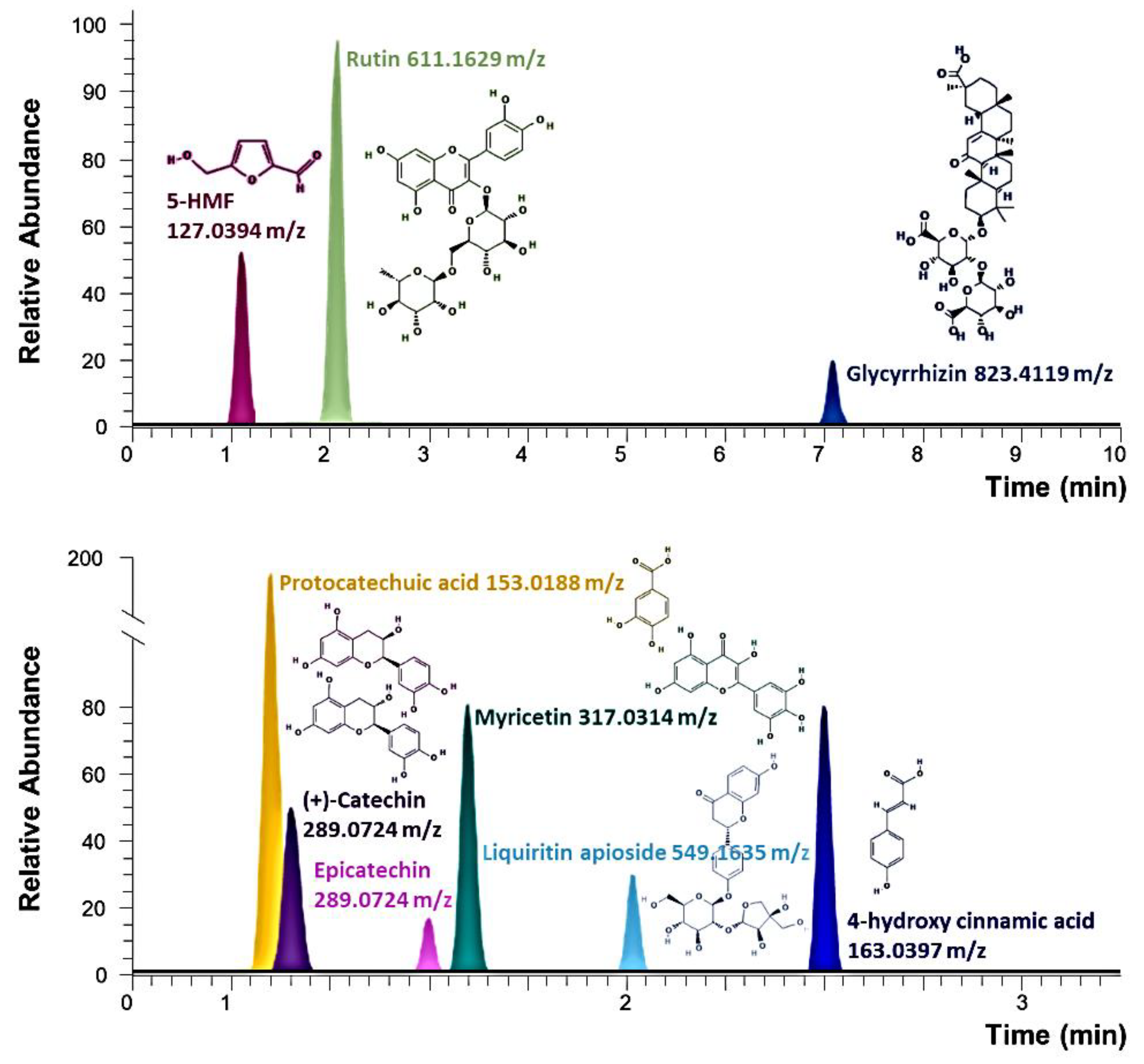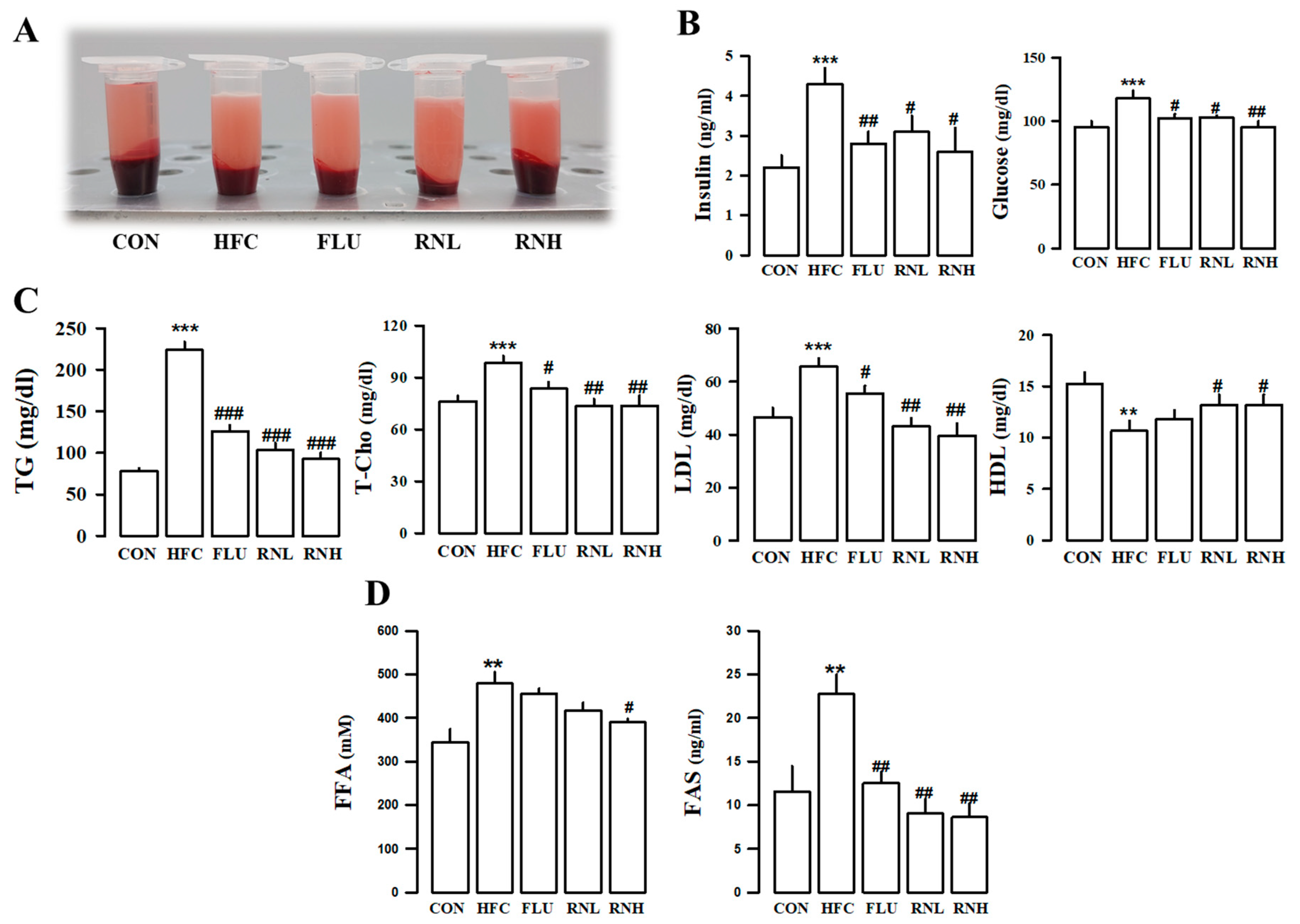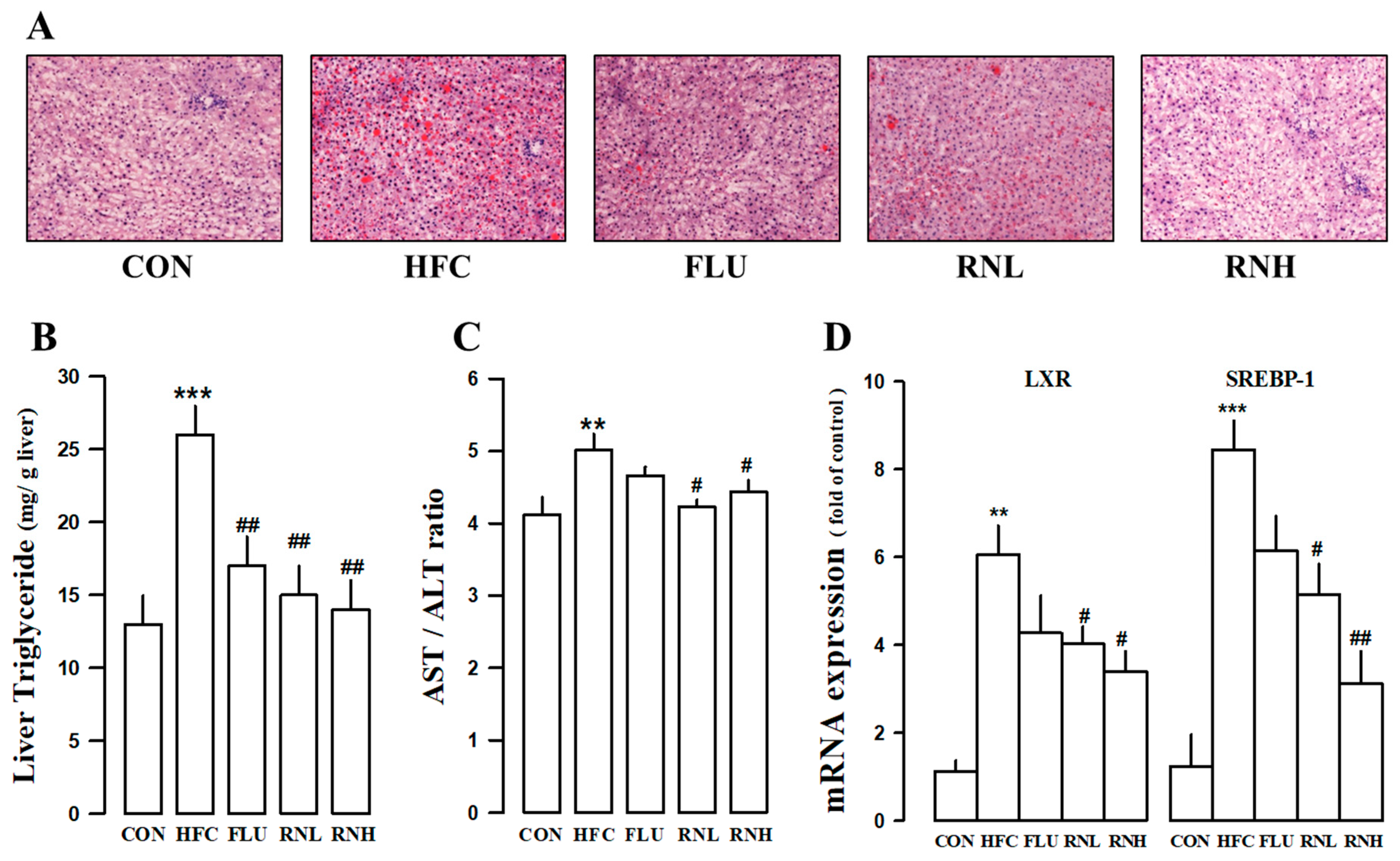Improvement of Hypertriglyceridemia by Roasted Nelumbinis folium in High Fat/High Cholesterol Diet Rat Model
Abstract
:1. Introduction
2. Materials and Methods
2.1. Preparation of Roasted Nelumbinis folium (RN) Component Analysis
2.2. Animals and Treatment
2.3. Changes in Vascular Tone Relaxation and Systolic Blood Pressure
2.4. Hematological Analysis
2.5. Extraction of RNA and Quantitative Real-Time Polymerase Chain Reaction (qPCR) Analysis
2.6. Concentration of Hepatic TGs
2.7. Histopathological Staining of Tissues
2.8. Statistical Analysis
3. Results
3.1. Analysis of the Components of Roasted RN
3.2. Effect of RN on Body and Tissue Weight Changes in High Fat/Cholesterol Diet Fed Rats
3.3. Effects of RN on Vascular Dysfunction in HFC Diet Rats
3.4. Effect of RN on Hematological Changes in HFC Diet-Fed Rats
3.5. Effect of RN on Changes in the Size of Epididymal Adipocytes in HFC Diet Rats
3.6. Effect of RN on Liver Function and Hepatic Lipids in HFC Diet-Fed Rats
4. Discussion
5. Conclusions
Supplementary Materials
Author Contributions
Funding
Conflicts of Interest
References
- Huțanu, A.; Iancu, M.; Maier, S.; Bălaşa, R.; Dobreanu, M. Plasma Biomarkers as Potential Predictors of Functional Dependence in Daily Life Activities after Ischemic Stroke: A Single Center Study. Ann. Indian Acad. Neurol. 2020, 23, 496–503. [Google Scholar] [PubMed]
- Pol, T.; Held, C.; Westerbergh, J.; Lindbäck, J.; Alexander, J.H.; Alings, M.; Erol, C.; Goto, S.; Halvorsen, S.; Huber, K.; et al. Dyslipidemia and Risk of Cardiovascular Events in Patients with Atrial Fibrillation Treated with Oral Anticoagulation Therapy: Insights from the ARISTOTLE (Apixaban for Reduction in Stroke and Other Thromboembolic Events in Atrial Fibrillation) Trial. J. Am. Heart Assoc. 2018, 7, e007444. [Google Scholar] [CrossRef] [Green Version]
- Schroor, M.M.; Sennels, H.P.; Fahrenkrug, J.; Jørgensen, H.L.; Plat, J.; Mensink, R.P.; Schroor, M.M. Diurnal Variation of Markers for Cholesterol Synthesis, Cholesterol Absorption, and Bile Acid Synthesis: A Systematic Review and the Bispebjerg Study of Diurnal Variations. Nutrients 2019, 11, 1439. [Google Scholar] [CrossRef] [PubMed] [Green Version]
- GBD 2017 Causes of Death Collaborators. Global, regional, and national age-sex-specific mortality for 282 causes of death in 195 countries and territories, 1980–2017: A systematic analysis for the Global Burden of Disease Study 2017. Lancet 2018, 392, 1736–1788. [Google Scholar] [CrossRef] [Green Version]
- Sniderman, A.D.; Couture, P.; Martin, S.S.; DeGraaf, J.; Lawler, P.R.; Cromwell, W.C.; Wilkins, J.T.; Thanassoulis, G. Hypertriglyceridemia and cardiovascular risk: A cautionary note about metabolic confounding. J. Lipid. Res. 2018, 59, 1266–1275. [Google Scholar] [CrossRef] [PubMed] [Green Version]
- Varbo, A.; Nordestgaard, B.G. Remnant cholesterol and ischemic heart disease. Curr. Opin. Lipidol. 2014, 25, 266–273. [Google Scholar] [CrossRef]
- Hooper, L.; Martin, N.; Jimoh, O.F.; Kirk, C.; Foster, E.; Abdelhamid, A.S. Reduction in saturated fat intake for cardiovascular disease. Cochrane Database Syst. Rev. 2020, 5, CD011737. [Google Scholar] [CrossRef]
- Chen, H.W.; Yang, M.Y.; Hung, T.W.; Chang, Y.C.; Wang, C.J. Nelumbo nucifera leaves extract attenuate the pathological progression of diabetic nephropathy in high-fat diet-fed and streptozotocin-induced diabetic rats. J. Food Drug Anal. 2019, 27, 736–748. [Google Scholar] [CrossRef]
- Kim, M.A. Triglyceride and Cardiovascular Disease. J. Lipid Atheroscler. 2013, 2, 1–8. [Google Scholar] [CrossRef]
- Lum-Naihe, K.; Toedebusch, R.; Mahmood, A.; Bajwa, J.; Carmack, T.; Kumar, S.A.; Ardhanari, S.; DeMarco, V.G.; Emter, C.A.; Pulakat, L. Cardiovascular disease progression in female Zucker Diabetic Fatty rats occurs via unique mechanisms compared to males. Sci. Rep. 2017, 7, 17823. [Google Scholar] [CrossRef] [Green Version]
- Kloska, A.; Malinowska, M.; Gabig-Cimińska, M.; Jakóbkiewicz-Banecka, J. Lipids and Lipid Mediators Associated with the Risk and Pathology of Ischemic Stroke. Int. J. Mol. Sci. 2020, 21, 3618. [Google Scholar] [CrossRef] [PubMed]
- Shabana; Shahid, S.U.; Sarwar, S. The abnormal lipid profile in obesity and coronary heart disease (CHD) in Pakistani subjects. Lipids Health Dis. 2020, 19, 73. [Google Scholar] [CrossRef] [PubMed] [Green Version]
- Wu, Y.; Tan, F.; Zhang, T.; Xie, B.; Ran, L.; Zhao, X. The anti-obesity efect of lotus leaves on high-fat-diet-induced obesity by modulating lipid metabolism in C57BL/6J mice. Appl. Biol. Chem. 2020, 63, 1–11. [Google Scholar] [CrossRef]
- You, J.S.; Lee, Y.J.; Kim, K.S.; Kim, S.H.; Chang, K.J. Ethanol extract of lotus (Nelumbo nucifera) root exhibits an anti-adipogenic effect in human pre-adipocytes and anti-obesity and anti-oxidant effects in rats fed a high-fat diet. Nutr. Res. 2014, 34, 258–267. [Google Scholar] [CrossRef]
- Ye, L.H.; He, X.X.; Kong, L.T.; Liao, Y.H.; Pan, R.L.; Xiao, B.X.; Liu, X.M.; Chang, Q. Identification and characterization of potent CYP2D6 inhibitors in lotus leaves. J. Ethnopharmacol. 2014, 153, 190–196. [Google Scholar] [CrossRef]
- Lia, L.; Shu, Z.; Li, X.R.; Yang, S.L.; Hao, L.L. Studies of burnt Folium Nelumbinis in anastalsis and processing. J. Chin. Med. Mater. 2010, 33, 1852–1855. [Google Scholar]
- Kim, H.Y.; Oh, H.C.; Li, X.; Cho, K.W.; Kang, D.G.; Lee, H.S. Ethanol extract of seeds of Oenotheraodorata induces vasorelaxation via endothelium-dependent NO-cGMP signaling through activation of Akt-eNOS-sGC pathway. J. Ethnopharmacol. 2011, 133, 315–323. [Google Scholar] [CrossRef]
- Cavonius, L.R.; Carlsson, N.G.; Undeland, I. Quantification of total fatty acids in microalgae: Comparison of extraction and transesterification methods. Anal. Bioanal. Chem. 2014, 406, 7313–7322. [Google Scholar] [CrossRef] [Green Version]
- Hariri, N.; Thibault, L. High-fat diet-induced obesity in animal models. Nutr. Res. Rev. 2010, 23, 270–299. [Google Scholar] [CrossRef] [Green Version]
- Petrie, J.R.; Guzik, T.J.; Touyz, R.M. Diabetes, hypertension, and cardiovascular disease: Clinical insights and vascular mechanisms. Can. J. Cardiol. 2018, 34, 575–584. [Google Scholar] [CrossRef] [Green Version]
- Iqbal, J.; Al Qarni, A.; Hawwari, A.; Alghanem, A.F.; Ahmed, G. Metabolic Syndrome, Dyslipidemia and Regulation of Lipoprotein Metabolism. Curr. Diabetes Rev. 2018, 14, 427–433. [Google Scholar] [CrossRef] [PubMed]
- Sang, M.; Du, G.; Hao, J.; Wang, L.; Liu, E.; Zhang, Y.; Wang, T.; Gao, X.; Han, L. Modeling and optimizing inhibitory activities of Nelumbinis folium extract on xanthine oxidase using response surface methodology. J. Pharm. Biomed. Anal. 2017, 139, 37–43. [Google Scholar] [CrossRef] [PubMed]
- Teng, H.; Fan, X.; Lv, Q.; Zhang, Q.; Xiao, J.; Qian, Y.; Zheng, B.; Gao, H.; Gao, S.; Chen, L. Folium nelumbinis (Lotus leaf) volatile-rich fraction and its mechanisms of action against melanogenesis in B16 cells. Food Chem. 2020, 330, 127030. [Google Scholar] [CrossRef] [PubMed]
- Chung, H.S.; Lee, H.J.; Shim, I.S.; Bae, H.S. Assessment of anti-depressant effect of nelumbinis semen on rats under chronic mild stress and its subchronic oral toxicity in rats and beagle dogs. BMC Complement Altern. Med. 2012, 12, 68. [Google Scholar] [CrossRef] [PubMed] [Green Version]
- Huang, B.; Ban, X.Q.; He, J.S.; Tong, J.; Tian, J.; Wang, Y.W. Hepatoprotective and antioxidant activity of ethanolic extracts of edible lotus (Nelumbo nucifera Gaertn.) leaves. Food Chem. 2010, 120, 873–878. [Google Scholar] [CrossRef]
- Nakamura, S.; Nakashima, S. Tanabe, GAlkaloid constituents from flower buds and leaves of sacred lotus (Nelumbo nucifera) with melanogenesis inhibitory activity in B16 melanoma cells. Bioorganic Med. Chem. 2013, 21, 779–787. [Google Scholar] [CrossRef]
- Adams, S.P.; Sekhon, S.S.; Tsang, M.; Wright, J.M. Fluvastatin for lowering lipids. Cochrane Database Syst. Rev. 2018, 3, CD012282. [Google Scholar] [CrossRef]
- Wolfsegger, M.J.; Jaki, T.; Dietrich, B.; Kunzler, J.A.; Barker, K. A note on statistical analysis of organ weights in non-clinical toxicological studies. Toxicol. Appl. Pharmacol. 2009, 240, 117–122. [Google Scholar] [CrossRef]
- Yu, T.; Zhao, L.; Zhang, J.C.; Xuan, D.Y. Impacts of periodontitis on visceral organ weight and weight percentage in obese mice. West China J. Stomatol. 2018, 36, 514–520. [Google Scholar]
- Stenkula, K.G.; Erlanson-Albertsson, C. Adipose cell size: Importance in health and disease. Am. J. Physiol. Regul. Integr. Comp. Physiol. 2018, 315, R284–R295. [Google Scholar] [CrossRef] [Green Version]
- Engin, A. Fat Cell and Fatty Acid Turnover in Obesity. Adv. Exp. Med. Biol. 2017, 960, 135–160. [Google Scholar] [PubMed]
- Toth, P.P. Triglyceride-rich lipoproteins as a causal factor for cardiovascular disease. Vasc. Health Risk Manag. 2016, 12, 171–183. [Google Scholar] [CrossRef] [Green Version]
- Karr, S. Epidemiology and management of hyperlipidemia. Am. J. Manag. Care 2017, 23, S139–S148. [Google Scholar]
- Elkins, C.; Friedrich, D. Hypertriglyceridemia: A review of the evidence. Nurse Pract. 2018, 43, 22–29. [Google Scholar] [CrossRef]
- Hara, T.; Kimura, I.; Inoue, D.; Ichimura, A.; Hirasawa, A. Free fatty acid receptors and their role in regulation of energy metabolism. Rev. Physiol. Biochem. Pharmacol. 2013, 164, 77–116. [Google Scholar] [PubMed]
- Marcelin, G.; Clément, K. Adipose tissue fibrosis: An aggravating factor in obesity. Med. Sci. 2018, 34, 424–431. [Google Scholar]
- Zhang, T.; Chen, J.; Tang, X.; Luo, Q.; Xu, D.; Yu, B. Interaction between adipocytes and high-density lipoprotein: New insights into the mechanism of obesity-induced dyslipidemia and atherosclerosis. Lipids Health Dis. 2019, 18, 223. [Google Scholar] [CrossRef] [Green Version]
- Zhang, Y.; He, W.; He, C.; Wan, J.; Lin, X.; Zheng, X.; Li, L.; Li, X.; Yang, X.; Yu, B.; et al. Large triglyceride-rich lipoproteins in hypertriglyceridemia are associated with the severity of acute pancreatitis in experimental mice. Cell Death Dis. 2019, 10, 728. [Google Scholar] [CrossRef]
- Nordestgaard, B.G.; Varbo, A. Triglycerides and cardiovascular disease. Lancet 2014, 384, 626–635. [Google Scholar] [CrossRef]
- Reiner, Ž. Hypertriglyceridaemia and risk of coronary artery disease. Nat. Rev. Cardiol. 2017, 14, 401–411. [Google Scholar] [CrossRef]
- Peng, J.; Luo, F.; Ruan, G.; Peng, R.; Li, X. Hypertriglyceridemia and atherosclerosis. Lipids Health Dis. 2017, 16, 233. [Google Scholar] [CrossRef] [PubMed] [Green Version]
- Matsumoto, S.; Gotoh, N.; Hishinuma, S.; Abe, Y.; Shimizu, Y.; Katano, Y.; Ishihata, A. The role of hypertriglyceridemia in the development of atherosclerosis and endothelial dysfunction. Nutrients 2014, 6, 1236–1250. [Google Scholar] [CrossRef] [PubMed] [Green Version]
- Subramanian, S.; Chait, A. Hypertriglyceridemia secondary to obesity and diabetes. Biochim. Biophys. Acta 2012, 1821, 819–825. [Google Scholar] [CrossRef] [PubMed]
- Wong, W.Y.; Ward, L.C.; Fong, C.W.; Yap, W.N.; Brown, L. Anti-inflammatory γ- and δ-tocotrienols improve cardiovascular, liver and metabolic function in diet-induced obese rats. Eur. J. Nutr. 2017, 56, 133–150. [Google Scholar] [CrossRef]
- Gariani, K.; Ryu, D.; Menzies, K.J.; Yi, H.S.; Stein, S.; Zhang, H.; Perino, A.; Lemos, V.; Katsyuba, E.; Jha, P.; et al. Inhibiting poly ADP-ribosylation increases fatty acid oxidation and protects against fatty liver disease. J. Hepatol. 2017, 66, 132–141. [Google Scholar] [CrossRef] [Green Version]
- Xiao, C.T.; Hsieh, J.; Adeli, K.; Lewis, G.F. Gut-liver interaction in triglyceride-rich lipoprotein metabolism. Am. J. Physiol. Endocrinol. Metab. 2011, 301, E429–E446. [Google Scholar] [CrossRef] [Green Version]
- Wong, D.; Bach, H.; Sun, J.; Hmama, Z.; Av-Gay, Y. Mycobacterium tuberculosis protein tyrosine phosphatase (PtpA) excludes host vacuolarH+-ATPase to inhibit phagosome acidifcation. Proc. Natl. Acad. Sci. USA 2011, 108, 19371–19376. [Google Scholar] [CrossRef] [Green Version]
- Ni, M.; Zhang, B.; Zhao, J.; Feng, Q.; Peng, J.; Hu, Y.; Zhao, Y. Biological mechanisms and related natural modulators of liver X receptor in nonalcoholic fatty liver disease. Biomed. Pharmacother. 2019, 113, 108778. [Google Scholar] [CrossRef]
- Kirchgessner, T.G.; Sleph, P.; Ostrowski, J.; Lupisella, J.; Ryan, C.S.; Liu, X.; Fernando, G.; Grimm, D.; Shipkova, P.; Zhang, R.; et al. Beneficial and adverse effects of an LXR agonist on human lipid and lipoprotein metabolism and circulating. Cell Metab. 2016, 24, 223–233. [Google Scholar] [CrossRef] [Green Version]
- Li, P.; Spann, N.J.; Kaikkonen, M.U.; Lu, M.; Oh, Y.; Fox, J.N.; Bandyopadhyay, G.; Talukdar, S.; Xu, J.; Lagakos, W.S. NCoR repression of LXRs restricts macrophage biosynthesis of insulin-sensitizing omega 3 fatty acids. Cell 2013, 155, 200–214. [Google Scholar] [CrossRef] [Green Version]
- Okazaki, H.; Goldstein, J.L.; Brown, M.S.; Liang, G. LXR-SREBP-1c-phospholipid transfer protein axis controls very low-density lipoprotein (VLDL) particle size. J. Biol. Chem. 2010, 285, 6801–6810. [Google Scholar] [CrossRef] [PubMed] [Green Version]
- Shimano, H.; Sato, R. SREBP-regulated lipid metabolism: Convergent physiology-divergent pathophysiology. Nat. Rev. Endocrinol. 2017, 13, 710–730. [Google Scholar] [CrossRef] [PubMed]






| Weight (g) | CON | HFC | FLU | RNL | RNH |
|---|---|---|---|---|---|
| Final Body | 449.41 ± 7.67 | 498.13 ± 6.88 *** | 476.53 ± 4.43 # | 466.39 ± 5.44 # | 488.60 ± 9.26 |
| Epididymal fat pad | 2.89 ± 0.08 | 4.44 ± 0.11 *** | 3.89 ± 0.16 # | 3.41 ± 0.17 ### | 3.69 ± 0.16 ## |
| Liver | 9.37 ± 0.64 | 11.01 ± 0.36 *** | 8.81 ± 0.49 ## | 9.11 ± 0.46 ## | 9.39 ± 0.33 ## |
| Heart | 1.34 ± 0.02 | 1.44 ± 0.02 * | 1.41 ± 0.06 | 1.39 ± 0.04 # | 1.37 ± 0.05 # |
| Kidney | 2.46 ± 0.03 | 2.59 ± 0.06 | 2.44 ± 0.06 | 2.46 ± 0.04 | 2.36 ± 0.03 |
Publisher’s Note: MDPI stays neutral with regard to jurisdictional claims in published maps and institutional affiliations. |
© 2020 by the authors. Licensee MDPI, Basel, Switzerland. This article is an open access article distributed under the terms and conditions of the Creative Commons Attribution (CC BY) license (http://creativecommons.org/licenses/by/4.0/).
Share and Cite
Kim, H.Y.; Hong, M.H.; Kim, K.W.; Yoon, J.J.; Lee, J.E.; Kang, D.G.; Lee, H.S. Improvement of Hypertriglyceridemia by Roasted Nelumbinis folium in High Fat/High Cholesterol Diet Rat Model. Nutrients 2020, 12, 3859. https://doi.org/10.3390/nu12123859
Kim HY, Hong MH, Kim KW, Yoon JJ, Lee JE, Kang DG, Lee HS. Improvement of Hypertriglyceridemia by Roasted Nelumbinis folium in High Fat/High Cholesterol Diet Rat Model. Nutrients. 2020; 12(12):3859. https://doi.org/10.3390/nu12123859
Chicago/Turabian StyleKim, Hye Yoom, Mi Hyeon Hong, Kwan Woo Kim, Jung Joo Yoon, Jung Eun Lee, Dae Gill Kang, and Ho Sub Lee. 2020. "Improvement of Hypertriglyceridemia by Roasted Nelumbinis folium in High Fat/High Cholesterol Diet Rat Model" Nutrients 12, no. 12: 3859. https://doi.org/10.3390/nu12123859
APA StyleKim, H. Y., Hong, M. H., Kim, K. W., Yoon, J. J., Lee, J. E., Kang, D. G., & Lee, H. S. (2020). Improvement of Hypertriglyceridemia by Roasted Nelumbinis folium in High Fat/High Cholesterol Diet Rat Model. Nutrients, 12(12), 3859. https://doi.org/10.3390/nu12123859





